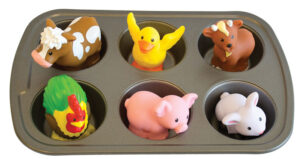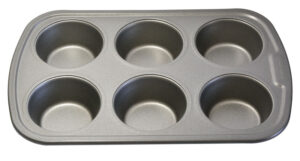Social interaction skills
A young infant participates in responsive interactions with a caregiver, focused on a toy rattle.



[Sit in a comfortable position holding an infant in your arms or on your lap, facing you.
Smile and begin talking with the infant. Example: “Hello, Jeremiah! You had a nice nap. You are all rested. Would you like to play with me? I am happy you are here today!” Watch the infant for signs of interest in engaging in a back-and-forth interaction with you. The infant may show interest in interacting by gazing at you, vocalizing, kicking his/her legs, or reaching toward you. Acknowledge the infant’s reactions, including any vocalizations, facial expressions, or gestures. Example: “You are smiling, Kiara! I smiled at you, and you are smiling at me!”
If the infant shows signs of disinterest, such as looking away, fussing, or turning away from you, end the activity and try engaging him/her at a later time.]
[Introduce the toy rattle.]
Look! I have a rattle for us to play with! Listen to the sound it makes. Maybe you would like to touch and hold the rattle.
[Hold the rattle about 12 inches from the infant. Gently shake and move the rattle slowly from side to side to attract the infant’s attention. Watch for the infant to respond by gazing, batting at, or reaching for the rattle. When the infant responds to the toy, move it to the infant’s hand. Hold the rattle for the infant to touch if he/she is not yet grasping.
Describe the infant’s reactions to the toy. Examples:
Continue interacting with the infant as he/she explores the rattle. Respond to vocalizations and facial expressions. Wrap up the activity when the infant begins to show signs of disinterest.]
[Offer a brief description of the interaction. Example: “Thank you for sharing time with me, Christina. We talked about the rattle. You moved the rattle and listened to the sound it made! You kicked your legs when you listened to the rattle. We had fun together.”]
Social interaction skills
An infant participates in open-ended play with a caregiver, focused on toy animal figures and a muffin pan.



Be Prepared: Place one animal figure in each cup of the muffin pan.
Invite an infant to sit with you on the floor to play. Introduce the muffin pan with animals and invite the infant to explore the new materials. Example: “We have some new toys today. Look at the animals in the pan! What would you like to do with our new toys?” As there are no specific ways to use the materials, this activity focuses on the interpersonal connection with the infant. Watch the infant’s reactions as he/she explores the materials and allow the infant to lead the activity. Some infants may remove the animal figures to explore them, whereas others may focus on taking out and returning the animal figures to the muffin pan.
and invite the infant to explore the new materials. Example: “We have some new toys today. Look at the animals in the pan! What would you like to do with our new toys?” As there are no specific ways to use the materials, this activity focuses on the interpersonal connection with the infant. Watch the infant’s reactions as he/she explores the materials and allow the infant to lead the activity. Some infants may remove the animal figures to explore them, whereas others may focus on taking out and returning the animal figures to the muffin pan.
Describe the infant’s actions. Examples: “You are smiling at the new toys. You
are taking out the animals. I wonder what you are going to do next!” “You are
holding a pig. You are looking at the pig’s curly tail.” “You are looking at the
toys and kicking your legs!” “I can see you are smiling and reaching for the
animals. You want to play with our new toys.”
If the infant appears hesitant to interact with the materials, offer suggestions
for play. Example: “You are looking at the animals. Would you like to take an
animal out? Which one should we look at first? How about the brown horse?”
Remember to pause for the infant to respond to your comments.
Social interaction skills
An older infant participates in responsive interactions with a caregiver that include opportunities to move animal figures from one muffin pan to another.



Be Prepared: Place one animal figure in each cup of one muffin pan. Leave the second pan empty.

 Invite an infant to play a game with you. The infant may wish to sit with you on the floor or stand at a low table for the activity. Introduce the muffin pan with animals inside and place the empty muffin pan nearby. Encourage the infant to explore the materials for several moments.
Invite an infant to play a game with you. The infant may wish to sit with you on the floor or stand at a low table for the activity. Introduce the muffin pan with animals inside and place the empty muffin pan nearby. Encourage the infant to explore the materials for several moments.
Invite the infant to take the toy animals out of the muffin pan and put them in the empty pan. Provide a demonstration and description with one animal figure, if appropriate. Describe the infant’s actions with the materials. Example: “You picked up a toy cow. Where are you going to put the cow? I see where you are putting it!” Follow the infant’s lead as he/she interacts with the materials. If the infant appears hesitant, offer help and suggestions to extend the play. Example: “You took all the animals out of the pan. Look at all the animals lined up on the floor! What would you like to do next? Maybe you can put the animals in this pan!” Also, follow the child’s lead on whether he/ she wants you to participate in moving around the animal figures. Example: “Would you like me to help you?” Recognize and respond to the infant’s reactions during the activity. Example: “I think you are excited about this new game! You are smiling and looking at all the animals.”
Open-ended activities are good opportunities to engage in positive interactions with an infant. You can promote responsive exchanges with the infant by commenting on the infant’s actions with and reactions to the materials, and perhaps also by helping the infant play with the materials. Use the infant’s reactions to the materials to shape the focus of your role, including whether the infant seems interested in your helping to manipulate the objects (especially in Options 2 and 3). Watch for and respond to vocalizations, focused looking, facial expressions (such as smiling) and other gestures or movements (such as clapping). Older infants may be interested in carrying a toy around the room. Maintain proximity to the walking infant and continue the interaction if possible.
Extra support
Enrichment
Materials Needed: assortment of small toys, such as animal figures; 2 muffin pans; basket
Provide opportunities for infants to independently explore the materials included in Options 2 and 3. Place the small toys in the basket and lay the muffin pans nearby. You may wish to place a few toys in the cups of both pans to generate interest in the materials. Infants may enjoy exploring the animals individually, or practice filling and dumping the muffin pans. Infants may enjoy watching their peers engage with the materials in similar ways. Describe the infants’ actions with the materials. Recognize facial expressions and repeat and extend any vocalizations while the infants play.
Materials Needed: various items to put in muffin pans (see below), 2–3 bowls or baskets, 2–3 muffin pans
Provide different types of items for children to explore putting in muffin pans. Infants will enjoy animal figures, large pop beads, rattles, and caged bells. Toddlers will enjoy counting bears, large pebbles, and plastic shapes from a shape sorter. Preschool-age children will enjoy large buttons (that are not a choking hazard), and craft pom-poms. Older children may like to sort items as they place them in a muffin pan. Older infants may enjoy putting items in, and then taking them out, of the pans.